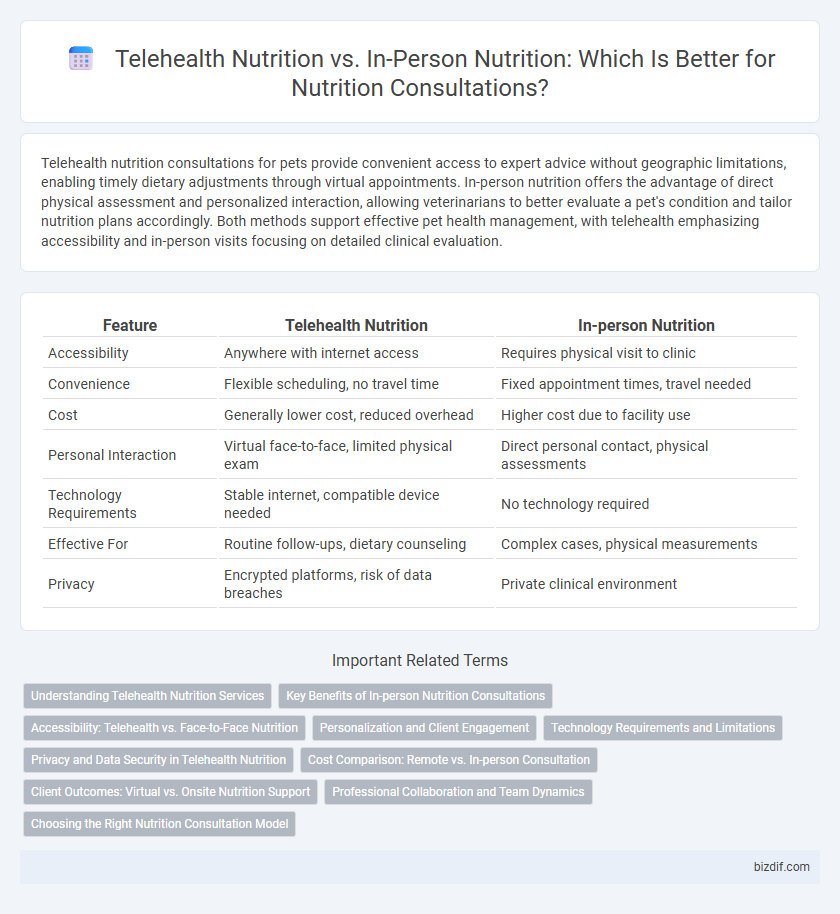Telehealth nutrition consultations for pets provide convenient access to expert advice without geographic limitations, enabling timely dietary adjustments through virtual appointments. In-person nutrition offers the advantage of direct physical assessment and personalized interaction, allowing veterinarians to better evaluate a pet's condition and tailor nutrition plans accordingly. Both methods support effective pet health management, with telehealth emphasizing accessibility and in-person visits focusing on detailed clinical evaluation.
Table of Comparison
| Feature | Telehealth Nutrition | In-person Nutrition |
|---|---|---|
| Accessibility | Anywhere with internet access | Requires physical visit to clinic |
| Convenience | Flexible scheduling, no travel time | Fixed appointment times, travel needed |
| Cost | Generally lower cost, reduced overhead | Higher cost due to facility use |
| Personal Interaction | Virtual face-to-face, limited physical exam | Direct personal contact, physical assessments |
| Technology Requirements | Stable internet, compatible device needed | No technology required |
| Effective For | Routine follow-ups, dietary counseling | Complex cases, physical measurements |
| Privacy | Encrypted platforms, risk of data breaches | Private clinical environment |
Understanding Telehealth Nutrition Services
Telehealth nutrition services provide remote access to registered dietitians through video calls, phone consultations, and digital platforms, allowing for flexible scheduling and personalized dietary guidance without geographic limitations. These services utilize interactive tools and electronic health records to track progress, deliver tailored meal plans, and offer real-time support, enhancing patient engagement and adherence. Telehealth nutrition expands access to specialized care for individuals in rural or underserved areas, making evidence-based nutrition consultation more convenient and accessible.
Key Benefits of In-person Nutrition Consultations
In-person nutrition consultations offer personalized assessments through direct physical examinations and immediate feedback, enhancing accuracy in dietary planning. Face-to-face interactions foster stronger client-provider rapport, improving motivation and adherence to nutrition goals. Access to on-site tools and resources enables comprehensive evaluations, including body composition analysis and real-time meal demonstrations.
Accessibility: Telehealth vs. Face-to-Face Nutrition
Telehealth nutrition significantly increases accessibility by eliminating geographical barriers and offering flexible scheduling, allowing patients in remote or underserved areas to receive expert dietary guidance. Face-to-face nutrition consultations provide direct, personalized interaction that may enhance rapport and tactile assessments but often require travel and fixed appointments, limiting access for those with mobility or time constraints. The choice between telehealth and in-person nutrition should consider patient convenience, availability of technology, and specific health needs to optimize care delivery.
Personalization and Client Engagement
Telehealth nutrition consultations offer tailored meal plans leveraging digital tools to enhance personalization through real-time data tracking and instant feedback. In-person nutrition sessions provide face-to-face interaction, fostering deeper client engagement and immediate behavioral support. Both formats emphasize customized goals, but telehealth maximizes convenience while in-person visits strengthen relational dynamics.
Technology Requirements and Limitations
Telehealth nutrition consultations require reliable internet connectivity, compatible devices such as smartphones or computers, and secure video conferencing platforms to ensure effective communication between dietitians and clients. In-person nutrition visits eliminate technological barriers but require physical presence, making access dependent on location and mobility. Telehealth may face limitations including technical difficulties, reduced ability to perform physical assessments, and challenges in building rapport compared to face-to-face interactions.
Privacy and Data Security in Telehealth Nutrition
Telehealth nutrition consultations employ advanced encryption and secure data protocols to protect patient privacy and ensure compliance with HIPAA regulations, minimizing risks associated with unauthorized access. In-person nutrition visits offer physical privacy but may face challenges such as paper record vulnerabilities and limited control over digital data storage. Telehealth platforms provide audit trails and controlled access measures that enhance data security, making them a reliable option for confidential nutrition counseling.
Cost Comparison: Remote vs. In-person Consultation
Telehealth nutrition consultations typically offer lower costs compared to in-person visits due to reduced overhead expenses such as facility fees and travel. Patients save on transportation and time, making remote nutrition services more accessible and budget-friendly. Insurance coverage for telehealth nutrition varies but often provides comparable reimbursement rates, enhancing its affordability relative to traditional in-person consultations.
Client Outcomes: Virtual vs. Onsite Nutrition Support
Telehealth nutrition consultations offer comparable client outcomes to in-person sessions by providing personalized dietary assessments and goal tracking through digital platforms. Studies indicate remote nutrition support maintains high levels of client engagement and adherence, facilitating effective weight management and chronic disease control. Onsite nutrition support provides hands-on evaluations and immediate biochemical measurements, which can enhance tailored intervention accuracy in complex cases.
Professional Collaboration and Team Dynamics
Telehealth nutrition consultations enhance professional collaboration by enabling seamless communication among dietitians, physicians, and specialists through digital platforms, improving coordinated care. In-person nutrition sessions foster immediate team dynamics with real-time interactions, facilitating quick adjustments based on direct observation and patient feedback. Both methods support multidisciplinary approaches but differ in flexibility and immediacy of collaborative input.
Choosing the Right Nutrition Consultation Model
Choosing the right nutrition consultation model depends on individual needs, accessibility, and lifestyle preferences. Telehealth nutrition offers convenience, broader provider options, and flexible scheduling, ideal for busy or remote clients. In-person nutrition provides hands-on assessments and personalized rapport, beneficial for those requiring detailed physical evaluations or immediate feedback.
Telehealth Nutrition vs In-person Nutrition Infographic

 bizdif.com
bizdif.com